Rooftop gardens help turn urban spaces into lush, sustainable retreats that boost property value and support environmental health. They reduce heat, improve air quality, manage stormwater, and create habitats for wildlife. With growing market trends and various incentives, more cities are making these green spaces easier to install. Innovations in materials and smart systems further enhance their benefits. Keep exploring to discover how rooftop gardens can transform your city and community.
Key Takeaways
- Rooftop gardens transform unused urban rooftops into lush green spaces, offering aesthetic, environmental, and social benefits.
- They help reduce urban heat island effects and improve air quality through vegetation and reflective surfaces.
- Incorporating rooftop gardens can increase property values and attract tenants seeking green, sustainable environments.
- Governments provide incentives, streamlined permits, and zoning adjustments to promote rooftop garden installations.
- Innovative technologies like smart irrigation and sustainable materials make creating and maintaining rooftop retreats more accessible.
The Economic Edge of Rooftop Gardens
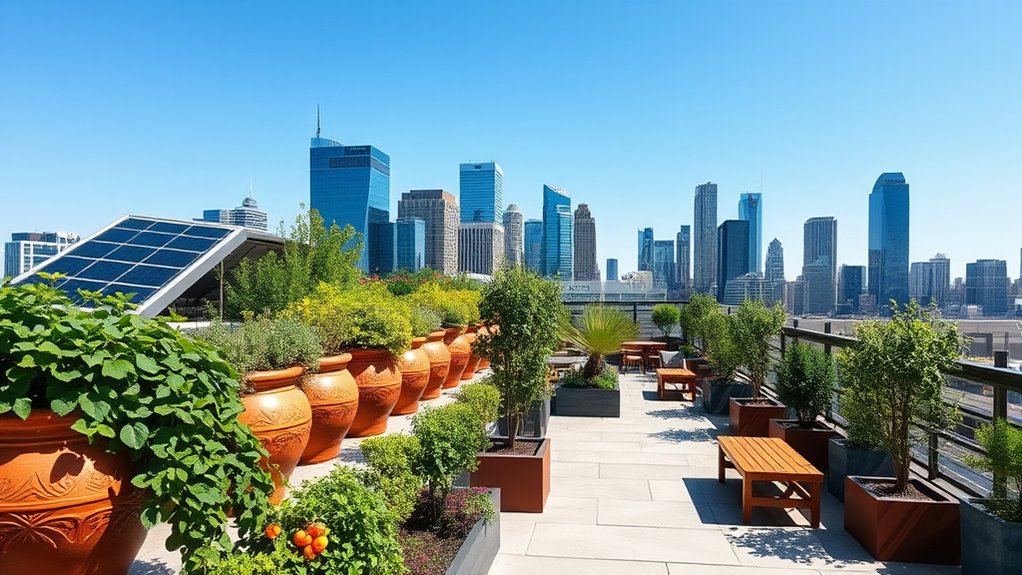
Rooftop gardens offer significant economic benefits that can boost property value and reduce operating costs. Improved rooftop aesthetics make buildings more attractive, increasing their market appeal and potentially raising property values by 11-20%. A lush, green rooftop enhances the building’s exterior, drawing positive attention and making neighborhoods more desirable. Additionally, installing rooftop gardens can support building structural integrity by adding a protective layer that shields the roof from weather damage. This can extend the lifespan of the roof and lower maintenance expenses over time. Green roofs also help manage stormwater runoff, which can prevent costly flooding and water damage. Incorporating safety features into rooftop gardens ensures they are secure and user-friendly for residents and visitors. These aesthetic and protective features not only increase the building’s worth but also create a more appealing environment for tenants and buyers. Overall, rooftop gardens provide a smart investment that enhances property value while safeguarding structural health.
Growing Market and Incentives for Green Roofs
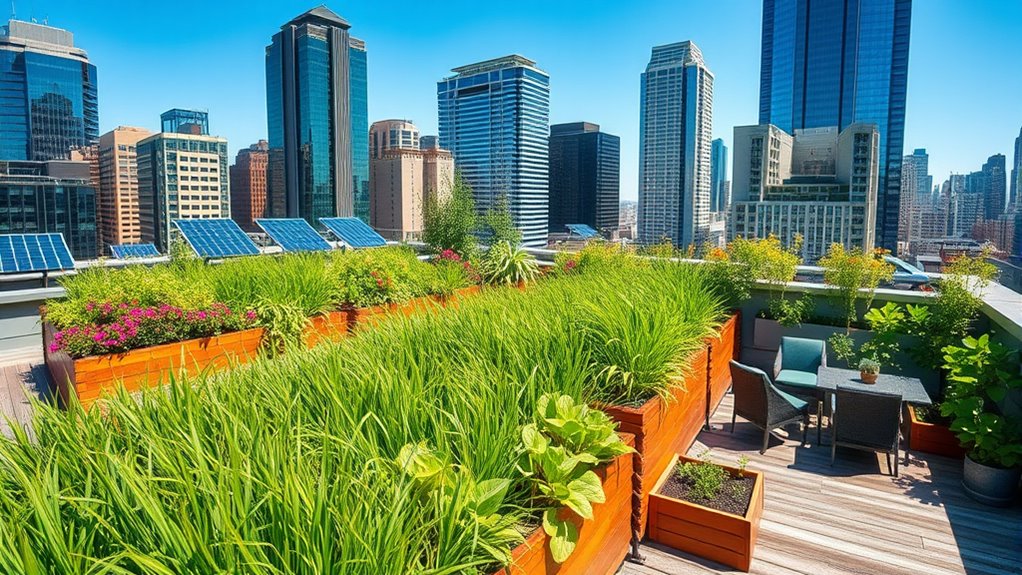
The market for green roofs is expanding rapidly, driven by urban growth and increased sustainability efforts worldwide. Financial incentives like subsidies and tax credits, along with supportive policies, make installing rooftop gardens more attractive. As these incentives grow, so does the potential for rooftop gardens to become a standard feature in sustainable urban development. Regional policies are increasingly favoring green infrastructure, further encouraging adoption. Additionally, advancements in sound design techniques can enhance the sensory experience of rooftop gardens through ambient soundscapes and audio elements that promote relaxation and environmental awareness.
Market Expansion Drivers
What factors are driving the rapid expansion of green roofs in urban areas? You’ll find that urbanization and population growth increase the demand for green spaces, turning rooftops into natural retreats. Many cities aim to preserve historical architecture by integrating eco-friendly upgrades, blending tradition with sustainability. Cultural influences also play a role, as communities embrace green living and biophilic design. Stricter environmental regulations push for greener construction practices, incentivizing roof gardens to meet stormwater and biodiversity goals. Technological innovations—like lightweight materials and smart systems—make installation easier and more cost-effective. Meanwhile, awareness of health benefits and lifestyle improvements drives demand. Altogether, these drivers create a compelling market, supported by investment trends and policy commitments, fostering widespread adoption of rooftop gardens in urban landscapes. The global roof garden market was valued at USD 8.5 billion in 2024 and is projected to reach USD 15.2 billion by 2033, reflecting the significant growth potential and increased investments in sustainable urban infrastructure.
Financial Incentive Programs
Financial incentive programs play a crucial role in accelerating the adoption of green roofs and rooftop solar systems. Historically, barriers like high upfront costs and limited access kept many from investing in these eco-friendly options. Federal incentives, such as a 30% tax credit for solar panel systems and financing included in mortgages, help ease these costs. Special federal grants support low-income homeowners, and programs target military personnel, broadening access. Utility-driven programs like Xcel Energy’s Solar*Rewards Community and Duke Energy’s subscription plans further promote rooftop solar by offering bill credits and lower barriers. Local governments also contribute, providing credits, bonuses, or discounts for green roof installations. These programs collectively reduce the financial hurdles, making sustainable urban upgrades more achievable for diverse communities. Recognizing and identifying angel numbers can inspire communities to pursue sustainable initiatives by fostering awareness and motivation.
Policy Support Initiatives
Growing recognition of the environmental and social benefits of rooftop gardens has prompted policymakers to implement targeted support initiatives. Cities update building codes and zoning regulations to promote rooftop farming and green roofs. Designated urban districts simplify land-use conflicts, while expedited permitting processes reduce project delays. Building codes are revised to pre-approve rooftop designs and materials, easing regulatory burdens. “Right-to-farm” ordinances protect urban farmers from nuisance complaints, ensuring smooth operations. These measures foster a growing market for rooftop gardens, making them more accessible and sustainable. Additionally, ongoing policy development continues to adapt and expand support for urban agriculture initiatives.
Innovations Shaping Urban Green Spaces

Are innovative building materials and advanced technologies transforming how we create urban green spaces? Absolutely. You’ll find that innovative substrates, like lightweight, high-strength materials, make rooftop gardens easier to install on diverse buildings while reducing structural load. Using recycled and sustainable materials minimizes environmental impact. Smart soil mixes with water-retentive polymers cut irrigation needs by up to 30%, making water use more efficient. Smart irrigation systems, equipped with sensors and weather data, optimize watering schedules and prevent overwatering. Automated drip irrigation delivers water directly to plant roots, boosting health and conserving resources. These innovations not only streamline installation and maintenance but also enhance water efficiency, thermal performance, and overall sustainability, transforming rooftops into thriving urban green retreats. These technological advances enable more widespread adoption of rooftop gardens by making them more accessible and resilient in various urban environments.
Environmental Advantages of Rooftop Gardening
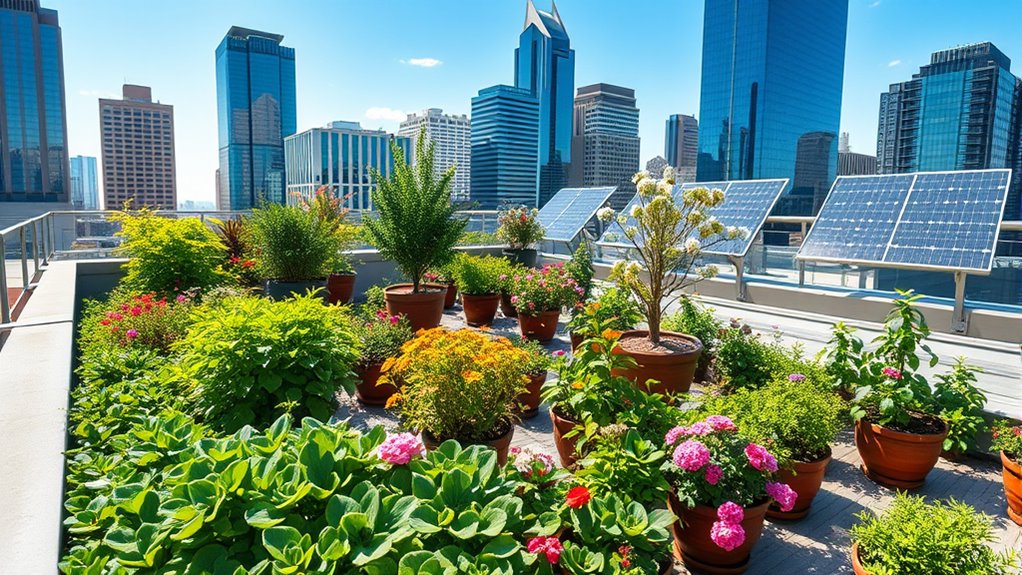
Rooftop gardens play a key role in reducing urban heat, managing stormwater, and supporting biodiversity. They help lower temperatures, absorb rainwater, and create habitats for various species, improving city environments. By integrating these green spaces, you contribute to more sustainable and resilient urban ecosystems. Visualizing success and setting clear intentions can further enhance the positive environmental impact of rooftop gardening initiatives.
Urban Heat Reduction
Implementing rooftop gardens can considerably reduce urban heat by cooling city environments during the hottest months. By blending greenery with architectural integration, you help counteract the urban heat island effect, which causes city temperatures to soar up to 10°F higher than surrounding areas. Extensive green roofs can lower urban air temperatures by up to 1°C, and city-wide coverage can decrease surface temperatures by over 2°C. These gardens provide shading from direct solar radiation, promote evaporative cooling, and reflect sunlight, all of which mitigate heat absorption. They also help restore some aspects of historical climate patterns by reducing heat retention in urban materials like asphalt and concrete. Additionally, content discoverability is enhanced through the use of hashtags and trending challenges, encouraging community engagement and awareness. Overall, rooftop gardens serve as essential tools in urban climate adaptation, making cities cooler, more comfortable, and resilient to extreme heat events.
Stormwater Management Benefits
Because they can absorb and slow down stormwater, rooftop gardens play a vital role in managing urban runoff. Historical precedents show that cultures worldwide have used green spaces to control water flow, influencing modern green roof designs. Vegetation and soil act like sponges, retaining rainfall and reducing runoff volume, which helps prevent flooding and erosion. Extensive green roofs with deeper soil layers enhance water retention, evaporating and transpiring moisture back into the atmosphere. This natural process lessens the burden on city drainage systems, lowering maintenance costs. Additionally, by filtering pollutants like heavy metals and sediments, rooftop gardens improve water quality before it reaches waterways. Incorporating on-device AI capabilities can optimize water management systems within green roofs, further enhancing their environmental benefits. Cultural influences emphasize harmony with nature, making stormwater management a sustainable, eco-friendly practice that supports resilient urban ecosystems.
Biodiversity Support
Have you ever considered how green rooftops can boost urban biodiversity? These gardens create essential wildlife habitats for insects, birds, and other species, supporting urban biodiversity. They serve as stopover points for migrating animals, enhancing ecosystem connectivity by linking fragmented habitats. Diverse plantings in rooftop gardens foster microhabitats for pollinators like bees and butterflies, indispensable for maintaining ecological networks. By attracting various fauna, rooftop gardens promote fundamental interactions such as pollination and pest control. They also act as ecological corridors, enabling wildlife movement across cities and counteracting habitat fragmentation. Additionally, the vegetation improves microclimates and air quality, creating healthier environments for urban species. Implementing urban greening strategies further amplifies these benefits by integrating natural elements into cityscapes. Overall, rooftop gardens play a key role in supporting biodiversity and strengthening urban ecosystems.
Boosting Urban Agriculture and Food Security
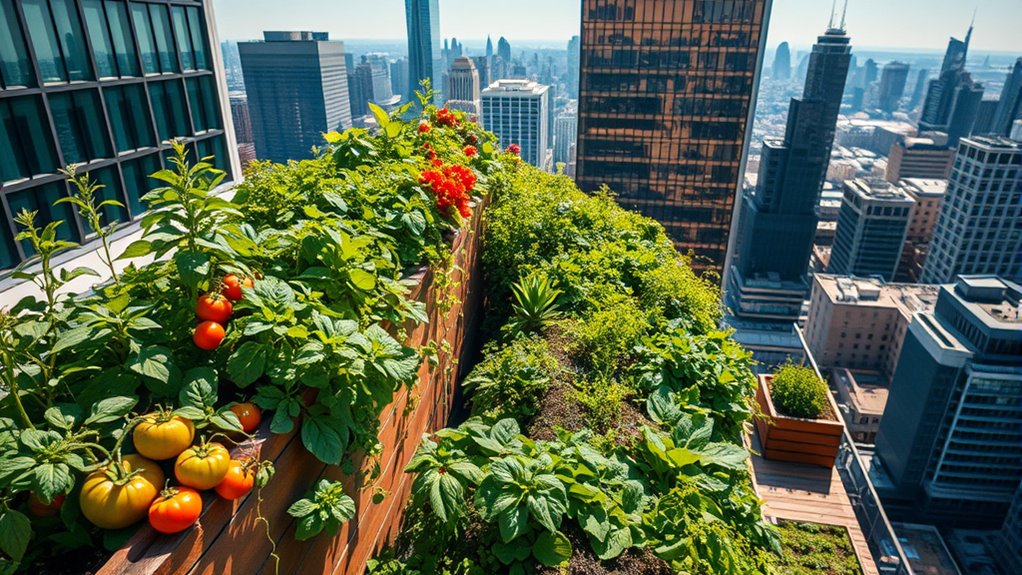
Ever wondered how rooftops can transform urban food systems? Vertical farming and soil-less cultivation enable you to grow more food in limited space, boosting food security. Rooftop farms like Brooklyn Grange in NYC can produce thousands of tons of vegetables annually, meeting a significant portion of local demand. Focusing on leafy greens like lettuce and mustard greens maximizes yield efficiency. Using green roof media blends tailored for urban agriculture improves crop growth, water retention, and sustainability. Rainwater harvesting supports eco-friendly irrigation, reducing dependency on external sources. These gardens lower transportation costs and greenhouse emissions while increasing access to fresh, nutritious produce. Not only do they strengthen city resilience, but they also create community spaces, promote healthier diets, and can even generate supplementary income, boosting local economies. Additionally, implementing cookie consent management tools ensures that user privacy preferences are respected while supporting innovative urban agriculture initiatives.
Policies and Community Strategies for Adoption
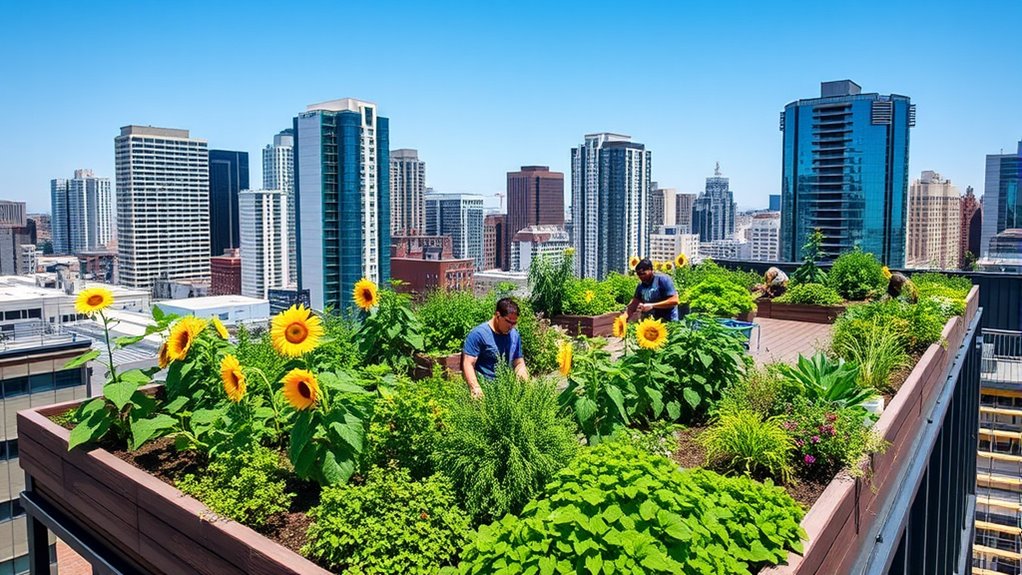
Implementing effective policies and community strategies is vital to expanding rooftop gardens in urban areas. To overcome policy barriers, governments offer financial incentives like grants, tax breaks, and subsidies, while streamlining permitting processes to reduce bureaucratic hurdles. Including rooftop gardens in urban planning frameworks and adjusting zoning laws, such as height exemptions, further promotes adoption. Community outreach plays an indispensable role by prioritizing underserved neighborhoods and partnering with local organizations to educate and support residents. These efforts foster social resilience and guarantee equitable access. Providing technical assistance, training workshops, and expert advice helps build capacity for rooftop gardening. When policies align with environmental goals—like stormwater management and urban cooling—they create a supportive environment that encourages widespread adoption of rooftop gardens across diverse communities. Additionally, understanding IRA tax implications can assist in financial planning for rooftop garden initiatives.
Creating Sustainable and Resilient Cities
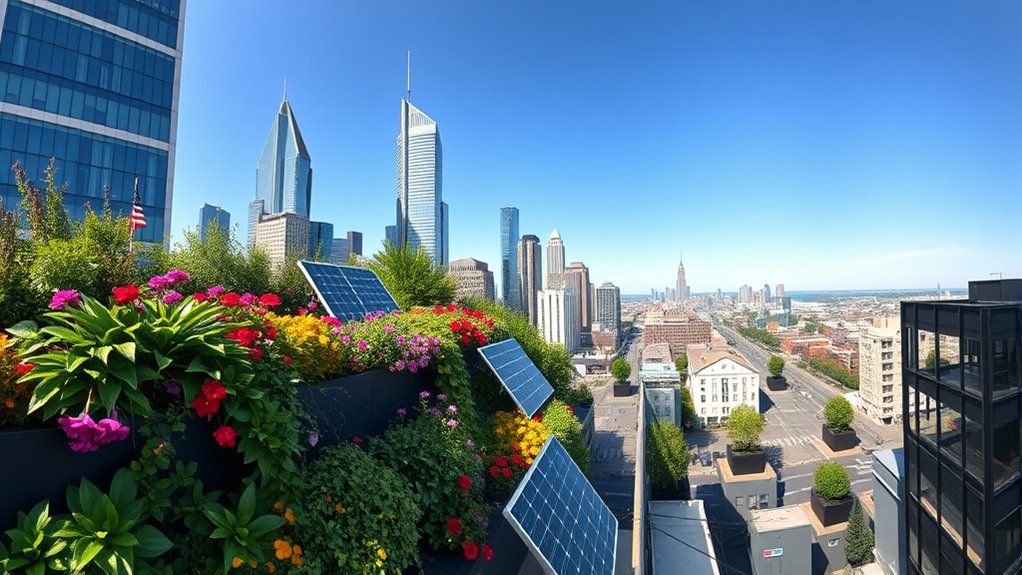
Integrating green infrastructure like rooftop gardens is essential for building climate-resilient cities. Historically, cities have used parks and green spaces to manage environmental challenges, and rooftop gardens extend this legacy upward. Aesthetic considerations play a role, transforming rooftops into inviting green retreats that enhance urban beauty. These gardens mitigate the urban heat island effect by cooling rooftops and surrounding air, while supporting biodiversity by providing habitats for pollinators and birds. They also improve air quality through pollutant filtering and reduce stormwater runoff by absorbing rainwater. Additionally, green roofs promote energy efficiency by offering passive cooling and insulation, lowering energy demands. As cities adapt to climate change, integrating rooftop gardens aligns with sustainability goals, blending historical urban greening with modern resilience strategies. Incorporating craft and textiles into rooftop garden designs can also create unique, handcrafted features that enhance the space’s aesthetic appeal and sustainability.
Frequently Asked Questions
What Are the Best Plants for Rooftop Gardens in Different Climates?
When choosing plants for rooftop gardens, you need to take into account plant selection and climate adaptation. In hot, dry climates, opt for succulents like cacti and aloe vera that handle drought well. For temperate areas, select shade-tolerant plants like hostas and blueberries. In alpine climates, hardy species such as moss campion and mountain mahogany thrive. Matching plants to your climate ensures a sustainable, vibrant rooftop garden that withstands local weather conditions.
How Can Rooftop Gardens Be Integrated With Renewable Energy Systems?
Think of rooftop gardens as a canvas, ready for a masterpiece of sustainability. You can integrate solar systems by installing PV panels with specialized bases that support both plants and energy storage. This approach guarantees ideal solar integration, reduces roof stress, and enhances energy efficiency. Plus, combining green roofs with solar energy creates a harmonious system, lowering cooling costs, boosting renewable energy production, and maximizing your rooftop’s environmental impact.
What Safety Considerations Are Necessary for Rooftop Garden Construction?
You need to guarantee safety when constructing a rooftop garden by obtaining the necessary building permits and conducting a thorough structural analysis. Verify that the roof can handle added loads like soil, plants, and furniture. Install fall protection measures such as guardrails and secure access points. Keep fire safety in mind with fire breaks and non-combustible materials. Regular inspections and adherence to safety standards will keep your project safe and compliant.
How Do Rooftop Gardens Impact Building Insurance and Liability?
Your rooftop garden could transform your insurance implications and liability concerns more than you’d imagine. It impacts your property’s value, possibly raising premiums due to water, fire, and structural risks. You must notify your insurer, guarantee proper structural support, waterproofing, and maintenance to avoid liability issues. If neglected, damages or injuries could lead to costly claims, making it essential to understand how rooftop gardens influence your coverage and responsibility.
What Are Cost-Effective Solutions for Irrigation and Stormwater Management?
You can save money on irrigation and stormwater management by using cost-effective solutions like drip irrigation and rainwater harvesting. Installing a DIY drip system with repurposed materials delivers water directly to your plants, reducing waste. Collect rainwater in barrels or tanks for irrigation, cutting down on municipal water use and managing stormwater runoff. These eco-friendly methods are affordable, efficient, and promote sustainability for your garden.
Conclusion
Imagine stepping onto your rooftop, where vibrant greenery spills over the edges, transforming gray cityscapes into lush retreats. Rooftop gardens not only add beauty but also boost your city’s economy, improve air quality, and foster community resilience. As you nurture these green spaces, you’re turning concrete jungles into thriving urban oases. Together, we can create sustainable, resilient cities that bloom with life, offering fresh air, food, and tranquility amidst the bustling skyline.









